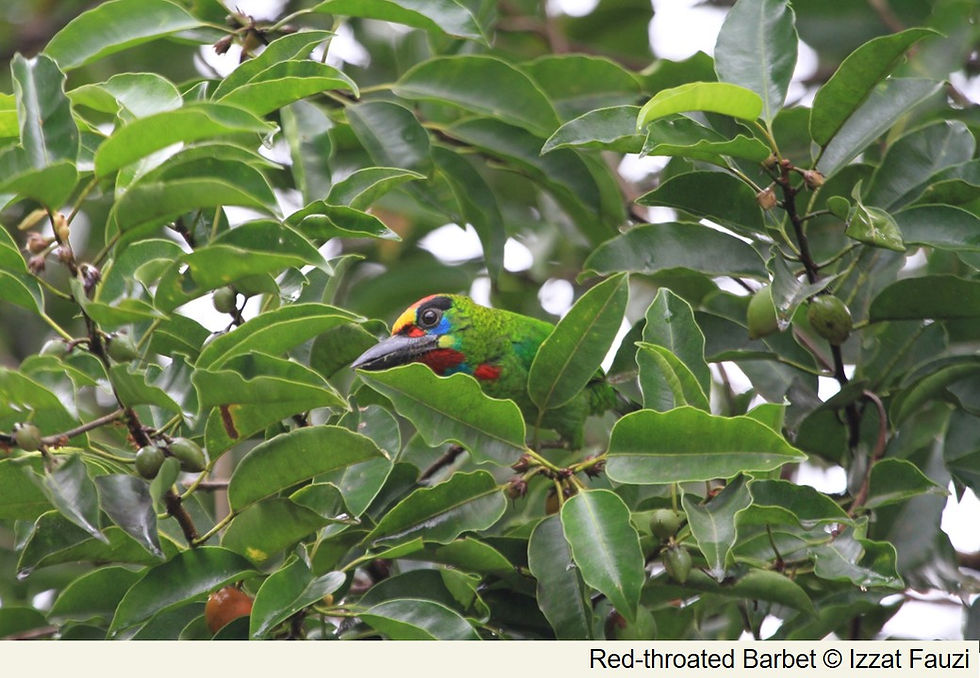Nature Education at Krau Wildlife Reserve with SBBG, Nature Guides and Herpetofauna SIG
- Izzat Fauzi
- Feb 10, 2018
- 3 min read

Krau Wildlife Reserve is the biggest wildlife reserve the Malaysian Peninsular and was established in 1923 with an area of 55, 159 hectares. Currently the area is 62,395 hectars after it was gazetted again in 1965 and 1968. It is located nearby Benom Mountain in Temerloh District, Pahang and drained by Krau River, Lompat River and Teris River. The altitude of the reserve is 43 metres in Kuala Lompat to 2,107 metres from the top of Benom Mountain. Within the reserve, there are Institute of Biodiversity and National Elephant Conservation Centre located in the southern part of the reserve with an entrance through Lanchang.
On 27th and 28th of January, two committee from Selangor Branch Bird Group-MNS were invited to lead birdwatching session with 20 MNS members at Institute of Biodiversity. Big thanks to the organizer, Selangor Branch Nature Guides, John for the opportunity. The morning was gloomy from the drizzles but the view of Pacific Swallow and Barn Swallow up close through the scope sparked birdwatching interest among some of the participants who went birdwatching for the first time.

A quick session before lunch yielded some interesting sightings. The fruiting tree in front of the institute provided a good view of Gold-whiskered Barbet and Red-throated Barbet. Oriental Magpie Robins were plenty all over the institute compound. Their whistling notes accompanied us throughout our stay. Other birds sighted were Rufous Woodpecker, Black-and-red Broadbill, Dark-throated Oriole, Blue-winged Leafbird, Red-eyes Bulbul, Stripe-throated Bulbul, Chestnut-breasted Malkoha, and plenty of Greater Racket-tailed Drongo.


After a visit to Kuala Gandah Elephant Conservation Center, a quick tea break reenergized the participants for the evening birdwatching session. The loud and harsh crackle calls of Oriental Pied Hornbill made everyone excited and we were treated with the view of two of them jumping on branches at the canopy. Due to the mature secondary forest around the compound, the birds were usually high up. However, we still managed to sight Grey-and-buff Woodpecker, Square-tailed Drongo-Cuckoo, Fiery minivet, Lesser Leafbird, Asian Brown Flycatcher and other birds. The beautiful, bubbly call of White-rumped Shama can be heard from the roadside, albeit no visual sighting over the two-day period.


As we were walking back to the institute, the harsh growling calls, ‘grrrraa’ echoed through the forest. Su Ping’s sharp eyes managed to locate a lone male Black Hornbill, perching on a stump. Through the scope, everybody had better appreciation of this magnificent bird. Suddenly, we heard another calls of Black Hornbill. A pair had decided to perch on the tree behind the main building. All in all, we were treated with the sighting of three Black Hornbills, which was definitely a great way to end the first day.

The night session was led by Herpetofauna expert, Steven Wong. His vast knowledge in amphibians, lizards and snakes is amazing and I learned about several species of frogs and toads like Glandular Frog, Common Grass Frog, White-lipped Frog and Giant River Toad that night. However, the presence of a pair of Brown Hawk Owl or Brown Boobook stole my attention that night. The close-up view of this amazing and cute owl was something that I will never forget.




The next morning, another birdwatching session was conducted and we were greeted with the "boo – book, boo – book, boo-book" call. The Brown Hawk Owl was perching on the lamp post and after a while, it retreated back to the jungle, ready to roost all day long. The honking call of Rhinoceros Hornbill alerted us of its presence, as two of them flew across the institute. The morning session was great with the view of Little Green Pigeon, Bronzed Drongo, Large Woodshrike, Lesser Cuckooshrike, Raffle’s Malkoha, Checker-throated Woodpecker and other birds. The high-pitched and metallic calls of Hill Myna and Black Magpie definitely drew our attention.




Even though most birds were high up in the canopy, the participants were very receptive with the guidance to spot the birds. Overall, we had clocked 58 species over the weekend. The list of birds is included below.







Comments